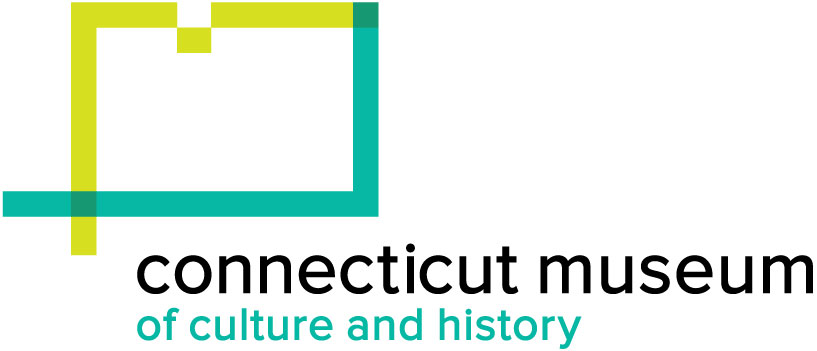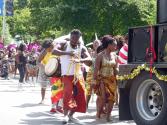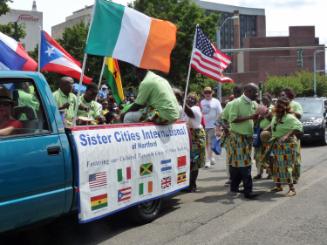West Indian Independence Day Parade, 2013
SubjectPortrait of
Mellissa Craig
SubjectPortrait of
Ashley Francis
Date2013 August 10
Mediumborn digital photography
ClassificationsGraphics
Credit LineConnecticut Cultural Heritage Arts Program collections
CopyrightIn Copyright
Object number2015.196.511.1-.14
DescriptionPhotographs of Mas Camp and other performers in the West Indian Independence Day Parade on August 10, 2013.
(.1-.3) Images of local groups marching in the Parade.
(.4-.5) Images of the king costume masquerader marching in the Parade.
(.6) Image of Mas Camp Exotic One's Band marching in the Parade behind their banner.
(.7-.8) Images of Mas Camp Exotic One's Queen Mellissa Craig marching in the Parade with the Band behind.
(.9-.11) Images of the Mas Camp Exotic One's Band marching in the Parade.
(.12-.13) Images of Mas Camp Exotic One's Junior Queen Ashley Francis marching in the Parade.
(.14) Image of the West Indian Independence Day Festival in Bushnell Park after the Parade.
NotesSubject Note: A significant wave of West Indian immigration to the United States began in the 1940s. Many settled in the Hartford area because the labor shortage of World War II meant there were available jobs in the tobacco fields along the Connecticut River Valley. Men worked in the fields while women often found work as housekeepers, teachers, nurses, and aides. Local organizations helped transition new immigrants to Connecticut culture and offered friendship, housing, economic opportunities, and community connections. Today, Connecticut’s West Indian community includes immigrants from all the islands in the Caribbean. They have established significant sports, cultural, and social clubs. The community has created vibrant dance and music groups, and produces an annual week-long festival that attracts audiences from all over the Northeast. With Greater Hartford now being home to the third largest West Indian community in the nation, beloved traditions like Carnival have been transplanted and sustained here.(.1-.3) Images of local groups marching in the Parade.
(.4-.5) Images of the king costume masquerader marching in the Parade.
(.6) Image of Mas Camp Exotic One's Band marching in the Parade behind their banner.
(.7-.8) Images of Mas Camp Exotic One's Queen Mellissa Craig marching in the Parade with the Band behind.
(.9-.11) Images of the Mas Camp Exotic One's Band marching in the Parade.
(.12-.13) Images of Mas Camp Exotic One's Junior Queen Ashley Francis marching in the Parade.
(.14) Image of the West Indian Independence Day Festival in Bushnell Park after the Parade.
In 1962, Jamaica and Trinidad and Tobago claimed their Independence from Great Britain. Since then, the West Indian Parade and Independence Celebration has been a highlight of Hartford’s summer activities. The Hartford celebration, held for a full week in August, is based on Carnival, a pre-Lenten celebration of spring and renewal in the islands, especially Trinidad. Masquerading, or playing Mas is an essential part of Carnival. Mas represents a theatrical adoption and presentation of roles and characters that originally expressed mockery of upper classes. Colorful, often spectacular costumes designed by traditional Mas artists depict fanciful themes or current issues. Gossamer fabrics, plumes and feathers, braiding, sequins and gems used in previous years are recycled to express the new year’s themes. Mas and Carnival serve as central expressions of Caribbean cultural identity and heritage.
During Carnival parades, groups of masqueraders form bands and dance to calypso or soca music. The bands have sections each led by a “frontliner” wearing a costume with a “backpack” frame that supports a headpiece. “Individual” character costumes are bigger still, with wings created from fabric stretched over a wire frame. The most elaborate costumes, the King and Queen, require bent steel frames on wheels so the person carrying the heavy costume can lead the band through the parade.
Subject Note: From 2011-2020, the Connecticut Cultural Heritage Arts Program at the Connecticut Historical Society partnered with the Connecticut Caribbean International Carnival Association to offer an annual summer youth employment program that trains Hartford youth in Carnival traditions central to their ethnic background. At the six-week “Mas Camp,” participants learned about the history and role of Carnival and masquerade. They designed and created their own Carnival costumes under the guidance of experienced Mas artists. The teens along with over two dozen volunteers, formed a Carnival Band that participated in several summer events showcasing Mas costumes totally made in Hartford. Mas Camp has helped to ensure that the Carnival tradition continues by training a new generation in the art of Mas making. In 2017, Mas Camp was selected as one of 50 exemplary youth programs nationwide by the National Arts and Heritage Youth Program.
Mas Camp was both a jobs program and an arts learning experience with social impact. The program mentored students in workplace readiness, social engagement, and cultural knowledge, offering alternative creative activities that fostered community involvement while providing fulfilling employment. Participants learned new skills including Caribbean cultural history, costume design, garment sewing and construction, creative movement, and teamwork. The teens experienced first-hand how to follow an artistic idea from background to completion and presentation, working both individually and collaboratively. Through the program, youth discovered that giving back to their community is an essential part of becoming a productive citizen. They experienced the joy of being part of a larger cultural group, and contributed their new skills to community activities.
During Mas Camp, the teens created their own costumes following themes and color schemes that they chose. The students and staff, along with volunteers from the community, formed a Carnival band they named Exotic One’s. Hartford costume maker Keimani “Q” Delpeche, who grew up in the Mas tradition in Trinidad and Boston, taught design and building of all the types of costumes. Choreographers including Clerona Cain and Coryse Villarouel developed dance routines with the students to train them in “displaying” their costumes in a parade. Some former students became peer educators helping to supervise Mas Camp activities in later years. The mentorship of several committed community educators and cultural leaders supported the teens and provided positive role models. The beauty of the costumes displayed by Hartford’s own masqueraders in the West Indian Parade and other festivals, along with the excitement of their dance routines, bring a tremendous energy and pride to the city’s West Indian communities.
During the summer of 2013, eighteen young people and over thirty volunteer adults and returning students participated. Costume maker Keimani “Q” Delpeche created the designs along with experienced assistant Lerry Cooper and volunteer parents. Artistic director Harold Springer, dance teacher Coryse Villarouel, and dance assistant Uniqua Jones trained the students in “displaying” their costumes in a parade. They formed a Carnival “Band” called the Exotic One’s with five sections of masqueraders in different color schemes portraying the theme of “Elements.” The Band performed with their costumes in the Taste of the Caribbean Festival at the Riverfront on August 3, and in the West Indian 51st Anniversary Independence Parade and Festival on August 10.
Biographical Note: Mellissa Craig is a long-time dance educator and performer based in Hartford. She has taught and danced with Sankofa Kuumba Dance Collective, Cultural Dance Troupe of the West Indies, is Principal Dancer and Founding Member at Island Reflections Dance Theatre Company, Ensemble Member at Justice Dance Performance Project, Inc., Arts Instructor at Greater Hartford Academy of the Arts, and a performer with FriendzWorldMusic. Mellissa is an experienced stilt walker and participates as Moko Jumbie for many West Indian events including the Taste of the Caribbean Festival. She carried the Queen costume for the Mas Camp Exotic One’s Band in 2014.
Biographical Note: Ashley Francis carried many Junior Queen costumes in the Exotic One's Band, in most of the years of the program. She was a gifted mas performer. From Hartford, Ashley attended the Classical Magnet School and the University of Hartford. She works as a makeup artist and model in Hartford.
Additional audio, video, and/or photographic materials exist in the archive relating to this community and these events.
Cataloging Note: This project was made possible in part by the Institute of Museum and Library Services MA-245929-OMS-20.
Status
Not on view2011 August 13



























